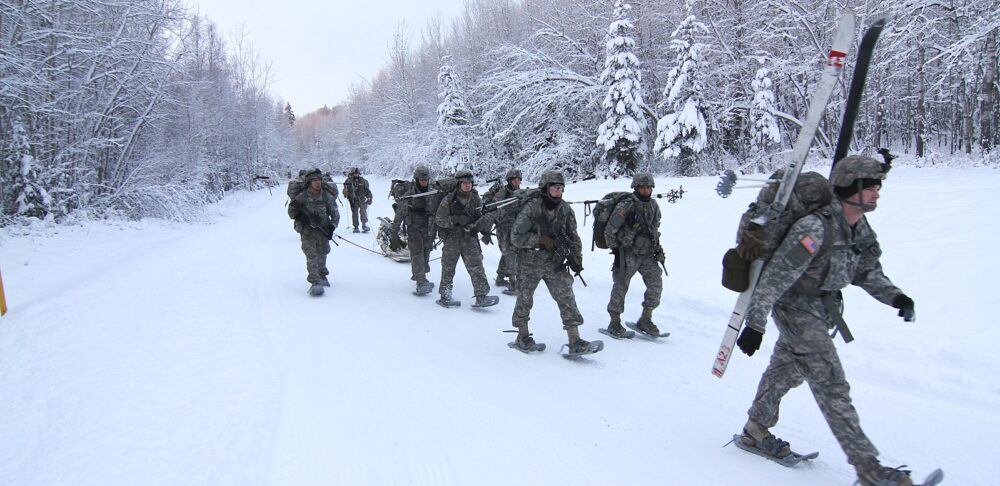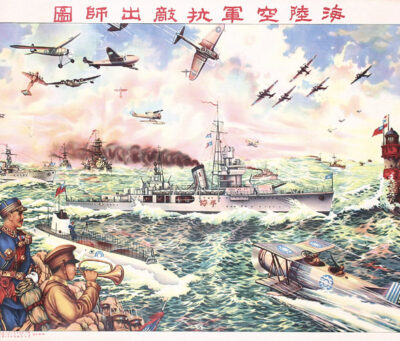For most of modern history, the Arctic has been a geopolitical anomaly — an economically, strategically, and environmentally vital region governed primarily through diplomacy and institutionalism, not power politics. Russia’s invasion of Ukraine, however, looks to have shifted the regional paradigm. Moscow’s diplomatic and economic decomposition has created a golden opportunity for China – a nation that has hovered around the edges of Arctic affairs – to assert itself as a primary player in shaping the region’s future. The United States will need to take decisive action to preserve the favorable elements of the status quo ante by augmenting Arctic power projection capabilities and coordinating with regional allies to counterbalance Beijing’s and Moscow’s overlapping ambitions.
The lack of an Arctic border has not prevented China from aggressively claiming its status as a regional stakeholder. China lobbied hard for, and was granted, observer status in the Arctic Council in 2013 and created the label of “near-Arctic state” to serve as a justification for its presence. [1] Such a move was in line with Beijing’s long-term strategy for the region, outlined in the 2018 “Polar Silk Road” white paper. A 2019 Arctic Institute report explains that “China’s Arctic strategy is focused on achieving two main goals: ensuring access to commercial opportunities in the Arctic and building capabilities to enforce its perceived rights and claims in the region.” [2] On the commercial front, China seeks access to the Arctic’s vast reserves of oil and natural gas, as well as deposits of rare earth minerals vital for modern technology. China is also interested in developing the Northern Sea Route (NSR), a maritime route along Russia’s coast that could cut shipping times between Western Europe and East Asia by as much as 40 percent. Russia has claimed that the NSR is included within its “internal waters” and has tried to regulate ship traffic along the route, a stance the United States rejects as a violation of the right to freedom of navigation under the United Nations Convention on the Law of the Sea. [3] At the present, the NSR is only traversable during certain months because of sea ice, but with rapid Arctic warming, the route is poised to play an increasingly important role in global trade. [4] Furthermore, in terms of defending its perceived rights and claims, a 2021 Brookings Institution report notes that “China has sent high-level figures to the region 33 times in the past two decades, engaged or joined most major Arctic institutions, sought a half-dozen scientific facilities in Arctic states, pursued a range of plausibly dual-use economic projects, expanded its icebreaker fleet, and even sent its naval vessels into the region.” [5]
However, China’s efforts to make headway in the Arctic have thus far been met with a chilly reception from potential partners. Apart from Russia, all Arctic states are close U.S. allies that treat Chinese Arctic investment with a degree of skepticism. Canada, Denmark, Iceland, and the United States have all intervened on multiple occasions to block potential acquisitions or investments that they feel would give Beijing a strategic advantage, such as its proposals to build a golf course and airstrip in one of the windiest regions of the world. [6] China also has been unable to successfully turn economic connections into political leverage. Despite its economic maneuvers, China’s ties to the Arctic nations (excluding the United States and Russia) are extremely limited. Despite the generally export-oriented economies of the Nordic countries and China’s massive domestic market, China accounts for only four percent of the exports of the five smallest Arctic economies. [7] As North Atlantic Treaty Organization (NATO) countries agree to take further steps to counter the strategic pacing challenge posed by China, it is unlikely that Beijing’s gateway to Arctic access runs through the West. [8]
While there is a natural alignment of interests in the region, Russia has historically held back from fully embracing China’s Arctic ambitions. At first glance, it would seem as though cooperation would be mutually beneficial. Developing the Northern Sea Route would make Russia a crucial player in global maritime trade, while giving China the chance to lower shipping costs and deepen trade with Europe. Chinese investment could also help Russia develop new oil and gas fields, sustaining long-term production and securing Moscow’s important role in international energy markets. [9] However, although joint projects such as the Yamal pipeline have been successful, widespread cooperation between the two countries has not yet materialized; Moscow has served as a roadblock, as well as an enabler, to Beijing’s plans. In an April 2022 War on the Rocks article, Jeremy Greenwood and Shuxian Luo argue that despite its joint Arctic endeavors, Moscow is distrustful of Beijing’s expanding Arctic presence as it sees China as just the first of other non-Arctic states that may attempt to influence Arctic policy and thus infringe upon Russia’s own legitimate regional interests. Russia opposed China’s observer status on the Arctic Council in 2013 and arrested an influential scientist in the Arctic community on charges of spying for Beijing as recently as 2020. [10] Russia’s discontent about serving as a vassal for Chinese interests in the Arctic mirrors its more general anxieties about economic dependence on China and the increasing asymmetry of their relationship. [11]
Despite Moscow’s historic hesitancy, Russia’s invasion of Ukraine has changed the nature of the Russo-Chinese partnership in the Arctic and opened the door to China in two important ways. First, Russia may no longer see the Arctic status quo as worth preserving. A precondition for Russian acquiescence to rules-based institutional cooperation with the West in the Arctic was the policy of “bracketing out” disputes over affairs in other parts of the world. [12] For example, even as diplomatic relations with Russia deteriorated after the illegal annexation of Crimea in 2014, cooperation in the Arctic on search and rescue missions continued because Arctic affairs were seen as independent from other areas of state competition. [13] However, in March of 2022, seven of eight Arctic Council members announced they were suspending cooperation with Russia over the invasion of Ukraine, a decision Moscow called “regrettable.” [14] Although there have been calls to re-engage Russia through Arctic institutions, now that Finland and Sweden are on the path to NATO membership (meaning seven of eight Arctic Council members will be NATO members), these efforts are unlikely to be successful.
Now that the Arctic has been openly politicized, Russia may seek to capitalize on its powerful position in the region. Max Bergmann argues that, as Russia loses clout in Europe and its economic and military shortcomings are laid bare, “Putin will inevitably engage in a desperate scramble to maintain Russia’s great power status.” [15] In short, the Kremlin will need to find another arena to exert authority and cling to long-term relevancy on the global stage. The Arctic is an ideal location for such muscle-flexing, as Russia maintains a decisive advantage in the region due to its powerful Northern Fleet. [16] Deepening cooperation with China gives Russia a wealthy and committed partner in maximizing its leverage in the Arctic against the West.
Second, if economic dependence on China increases in Russia’s post-war recovery, the Kremlin will become increasingly unable to refuse Beijing’s demands for greater Arctic access. Although Western sanctions have not decisively crippled the Russian economy as some experts predicted, the Kremlin is still facing years of stagnation. The oil and gas industry – the lifeblood of the Russian economy – is facing a host of problems, including waning demand, as Europe looks to end its fossil fuel dependence on Russia. To maintain oil and gas production levels in the near future, Russia will have to invest billions of dollars into developing new extraction fields offshore as well as in the Arctic — all without the technical expertise, technology, or capital of Western energy companies. [17]
Despite the self-proclaimed “no-limits friendship” between the two countries, China has so far displayed reticence in coming to Moscow’s economic aid for fear of secondary sanctions. [18] However, this is more of a short-term adaptation than a long-term strategy. Andrea Kendall-Taylor and David Shullman observe that immediately after the annexation of Crimea, the Chinese response to Russia’s attempts to deepen the relationship was tepid at best. Yet, in the years that followed, Beijing “recognize[d] the utility in building a stronger relationship with the Kremlin,” with the partnership crystallizing “around a fundamentally similar view of the United States as a primary strategic threat.” [19] This development impacted Arctic affairs as well, with China’s Silk Road Fund replacing Western energy companies such as Exxon and Eni as a major financier for Russia’s Yamal liquified natural gas project. Kendall-Taylor and Shullman conclude, “If past precedent repeats, China’s initially cautious support for Russia’s invasion will yield to bolder backing for Moscow and efforts to deepen the partnership once the international spotlight moves away from events in Ukraine.” [20] Strategic necessity will force the Kremlin to overlook its qualms about dependence on Beijing and open itself up to greater Chinese economic investment – and thus greater political influence – in the Arctic.
If the opportunity for greater cooperation comes to bear, China could seek to extract a number of lucrative concessions from Russia that further its Arctic goals. Focused infrastructure development in partnership with Russia would enable China to expand its physical presence in the Arctic. In 2016, the head of Russia’s State Commission for Arctic Development Dmitry Rogozin announced China was seen as being “among the top potential partners for developing the infrastructure of the [Northern Sea Route].” [21] In October 2022, a panel of Arctic security experts warned that China is quietly expanding its Arctic footprint through “an extensive partnership with Russia in areas ranging from multi-use ports and airfields to energy extraction.” Further development will likely occur increasingly on Beijing’s terms, as an economically devastated Russia will be less able to refuse even unpalatable Chinese investments. Beyond infrastructure, a December 2022 report from the RAND Corporation suggests a potential consequence of the current suspension of the Arctic Council may be “a push from Russia for a new (or drastically changed) Arctic governance institution, in which … other Arctic-interested states – such as China – might have a louder voice.” [22] Russia also could be strong-armed into opening Arctic access to China’s expanding icebreaker fleet. [23] In 2018, China finished constructing its second polar-class icebreaker and its third, commissioned in 2021, is planned to be operational by 2025 — achieving operational capacity that matches, if not exceeds, that of the United States. [24] The end result is that, as Professor Liselotte Odgaard argues in a recent Survival journal article, “If all of China’s plans for building Arctic infrastructure, surveillance and transport facilities obtained Russian approval, China would be able to operate commercially and militarily across the Northern Sea Route.” [25]
Increased Sino-Russian cooperation in the Arctic poses a real threat to U.S. economic and security interests. In the Arctic, to quote former Commandant of the U.S. Coast Guard Admiral Karl Schultz, “presence equals influence.” [26] Russian acquiescence to expanded Chinese presence in the Arctic – through infrastructure projects, a voice in Arctic institutions, and icebreaker development – would make China a much more formidable player in Arctic affairs. If its behavior in the South China Sea is any indication, China is not the reliable custodian of the global maritime commons it claims to be and will undoubtedly seek to exploit Arctic influence to advance its own interests. As the December 2022 RAND Corporation’s report concludes, “China’s holistic approach to competition means it will likely continue to strive to lay the groundwork necessary to turn the [Arctic] into a space where it can contest U.S. advantages, force the United States to expend resources, and pose potential challenges for the United States and its allies and partners.” [27] A desperate Russia could present problems as well by increasing the militarization of key choke points along Arctic maritime routes, such as the entry and exit to the Barents Sea. [28] If Washington remains complacent, U.S. policymakers will soon be forced to make concessions to not one but two great power rivals when crafting economic, security, and environmental strategy in the Arctic.
Countering Sino-Russian Arctic ambitions will first require acknowledging that the game has changed following the invasion of Ukraine. Although a return to open diplomacy and multilateral cooperation that includes Russia would be the ideal scenario, these traditional pillars of Arctic statecraft can no longer be effectively relied upon to manage regional competition. Establishing presence in the Arctic first and foremost requires the creation of robust icebreaker capabilities, which the United States currently lacks. Fortunately, deepening cooperation and icebreaker development with recent NATO member Finland and prospective member Sweden – which have nine and five icebreakers, respectively, and strong domestic production industries – could help remedy the gap. [29] In addition to icebreakers, the United States must take a multilateral approach to coordinating an Arctic security strategy that accounts for the likely Chinese intrusion. This will require unified public messaging about the intentions of Arctic states to preserve the rules-based institutional status quo, to continue engagement with Russia on mutually beneficial areas of cooperation (for example, search and rescue and environmental protections), and to keep Arctic policy strictly between Arctic states. But such messaging must also be underscored by a collective effort to augment operational and intelligence-gathering capabilities to deter Moscow and Beijing from, in Winston Churchill’s words, “temptations to a trial of strength” in the Arctic.
U.S. President Joe Biden will not wake up tomorrow to an Arctic sphere dominated by Russia and China. But with the invasion of Ukraine, China now has a clearer path to an Arctic foothold and a potential new area of competition to challenge U.S. primacy. The strategic choices the United States makes today will determine the operational environment U.S. policymakers will soon have to navigate in the frozen North.
Alexander Joel ’25 serves as the Campus Recruitment Officer at the AHS chapter at Dartmouth College, where he is majoring in Government and minoring in Russian Area Studies.
—
Notes:
[1] Stephanie Pezard et al., China’s Strategy and Activities in the Arctic: Implications for North American and Transatlantic Security, RR A1282-1-v2 (Santa Monica, CA: RAND, 2022), 7, https://doi.org/10.7249/rra1282-1-v2.
[2] Johan M. Seland and Heljar Havnes, “The Increasing Security Focus in China’s Arctic Policy,” The Arctic Institute Center for Circumpolar Security Studies, 13 August 2022, https://www.thearcticinstitute.org/increasing-security-focus-china-arctic-policy/.
[3] Thomas Nilsen, “Russian Parliament Passes Law Limiting Freedom of Navigation along Northern Sea Route,” The Independent Barents Observer, 1 December 2022, https://thebarentsobserver.com/en/arctic/2022/12/russian-parliament-passes-law-banning-freedom-navigation-along-northern-sea-route.
[4] Miaojia Liu and Jacob Kronbak, “The Potential Economic Viability of Using the Northern Sea Route (NSR) as an Alternative Route between Asia and Europe,” Journal of Transport Geography 18, no. 3 (May 2010): 434-444, https://doi.org/10.1016/j.jtrangeo.2009.08.004.
[5] Rush Doshi et al., “Northern Expedition: China’s Arctic Activities and Ambitions,” Brookings Institution, April 2021, https://www.brookings.edu/research/northern-expedition-chinas-arctic-activities-and-ambitions/.
[6] Pezard et al., 72.
[7] Doshi et al.
[8] Edward Wong and Steven Erlanger, “NATO Nations Grow More Receptive to U.S. Pleas to Confront China,” The New York Times, 30 November 2022, https://www.nytimes.com/2022/11/30/world/europe/nato-china-biden.html.
[9] Maria Rehman, “Changing Contours of Arctic Politics and the Prospects for Cooperation between Russia and China,” The Arctic Institute Center for Circumpolar Security Studies, 16 October 2022, https://www.thearcticinstitute.org/changing-contours-arctic-politics-prospects-cooperation-russia-china/.
[10] Jeremy Greenwood and Shuxian Luo, “Could the Arctic Be a Wedge between Russia and China?,” War on the Rocks, 31 March 2022, https://warontherocks.com/2022/04/could-the-arctic-be-a-wedge-between-russia-and-china/.
[11] “What Are the Weaknesses of the China-Russia Relationship?,” Center for Strategic and International Studies, 22 August 2022, https://chinapower.csis.org/china-russia-relationship-weaknesses-mistrust/.
[12] Henri-Nicolas Grossman, “The U.S. Is Unprepared for the ‘Scramble for the Arctic’,” The National Interest, 22 October 2020, https://nationalinterest.org/blog/reboot/us-unprepared-scramble-arctic-171107.
[13] Doshi et al.
[14] Timo Koivurova, “Is It Possible to Continue Cooperating with Russia in the Arctic Council?,” Georgetown Journal of International Affairs (28 June 2022), https://gjia.georgetown.edu/2022/06/29/is-it-possible-to-continue-cooperating-with-russia-in-the-arctic-council/.
[15] Max Bergmann, “Russia’s Coming Great Power Struggle,” Center for Strategic and International Studies, 3 January 2023, https://www.csis.org/analysis/russias-coming-great-power-struggle.
[16] Matthew Melino and Heather A. Conley, “The Ice Curtain: Russia’s Arctic Military Presence,” Center for Strategic and International Studies, 26 March 2020, https://www.csis.org/features/ice-curtain-russias-arctic-military-presence.
[17] Steven Pifer, “The Russia-Ukraine War and Its Ramifications for Russia,” Brookings Institution, 8 December 2022, https://www.brookings.edu/articles/the-russia-ukraine-war-and-its-ramifications-for-russia/.
[18] Christian Shepherd, “China Not Emerging as Lifeline for Sanction-Slammed Russian Economy,” The Washington Post, 2 March 2022, https://www.washingtonpost.com/world/2022/03/02/russia-economy-sanctions-china-support-ukraine/.
[19] Ling Guo and Steven L. Wilson, “China, Russia, and Arctic Geopolitics,” The Diplomat, 31 March 2020, https://thediplomat.com/2020/03/china-russia-and-arctic-geopolitics/.
[20] Andrea Kendall-Taylor and David O. Shullman, “Best and Bosom Friends: Why China-Russia Ties Will Deepen after Russia’s War on Ukraine,” Center for Strategic and International Studies, 22 June 2022, https://www.csis.org/analysis/best-and-bosom-friends-why-china-russia-ties-will-deepen-after-russias-war-ukraine.
[21] Camilla T. N. Sørensen and Ekaterina Klimenko, “Emerging Chinese-Russian Cooperation in the Arctic,” Policy Paper 46 (Stockholm, Sweden: SIPRI, June 2017), 21, https://www.sipri.org/sites/default/files/2017-06/emerging-chinese-russian-cooperation-arctic.pdf.
[22] Doshi et al.
[23] Steven Lee Myers and Somini Sengupta, “Latest Arena for China’s Growing Global Ambitions: The Arctic,” The New York Times, 24 May 2019, https://www.nytimes.com/2019/05/24/climate/china-arctic.html.
[24] Doshi et al.
[25] Liselotte Odgaard, “Russia’s Arctic Designs and NATO,” Survival 64, no. 4 (August 2022): 95, https://doi.org/10.1080/00396338.2022.2103259.
[26] David Vergun, “Coast Guard Commandant Wants Bigger Arctic Presence – How Cool Is That?,” U.S. Department of Defense, 4 December 2018, https://www.defense.gov/News/News-Stories/Article/Article/1705544/coast-guard-commandant-wants-bigger-arctic-presence-how-cool-is-that/.
[27] Doshi et al.
[28] Odgaard, 98.
[29] Tero Vauraste, “Cooperation Could Answer U.S. Icebreaking Needs,” The Maritime Executive, 4 August 2016, https://maritime-executive.com/editorials/cooperation-could-answer-us-icebreaking-needs.
Image: “Arctic Wolves Prowl Alaska,” by The U.S. Army, retrieved from https://commons.wikimedia.org/wiki/File:Arctic_Wolves_prowl_Alaska_(15804446250).jpg. This file is a work of a U.S. Army soldier or employee, taken or made as part of that person’s official duties. As a work of the U.S. federal government, it is in the public domain in the United States.



